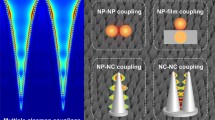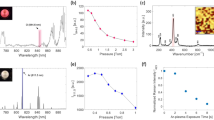Abstract
To make surface enhanced Raman scattering (SERS) sensors more practical, we propose nanoporous Ag disks as SERS-active plasmonic structures that can be readily inkjet-printed just before use to avoid degradation of SERS enhancement. Together with the aid of the enhanced plasmonic fields from the nanoporous Ag (confirmed by electromagnetic simulation), we utilize a coffee-ring effect to concentrate target analytes, which is demonstrated by confocal Raman measurements. By using the proposed SERS sensor, Raman signals of TiO2 nanoparticles with a concentration of ppm to sub-ppb have been successfully measured. TiO2 in commercial consumables has been also detected by distinguishing its crystalline phase.





Similar content being viewed by others
References
Nie, S., & Emory, S. R. (1997). Probing single molecules and single nanoparticles by surface-enhanced Raman scattering. Science, 275(5303), 1102–1106.
Kneipp, K., Wang, Y., Kneipp, H., Perelman, L. T., Itzkan, I., Dasari, R. R., et al. (1997). Single molecule detection using surface-enhanced Raman scattering (SERS). Physical Review Letters, 78(9), 1667–1670.
Stiles, P. L., Dieringer, J. A., Shah, N. C., & Duyne, R. P. V. (2008). Surface-enhanced Raman spectroscopy. Annual Review of Analytical Chemistry, 1(1), 601–626.
Sharma, B., Frontiera, R. R., Henry, A.-I., Ringe, E., & Van Duyne, R. P. (2012). SERS: Materials, applications, and the future. Materials Today, 15(1), 16–25.
Luo, S.-C., Sivashanmugan, K., Liao, J.-D., Yao, C.-K., & Peng, H.-C. (2014). Nanofabricated SERS-active substrates for single-molecule to virus detection in vitro: A review. Biosensors and Bioelectronics, 61, 232–240.
Ding, S.-Y., Yi, J., Li, J.-F., Ren, B., Wu, D.-Y., Panneerselvam, R., et al. (2016). Nanostructure-based plasmon-enhanced Raman spectroscopy for surface analysis of materials. [Review Article]. Nature Reviews Materials, 1, 16021.
Jeon, T. Y., Kim, D. J., Park, S.-G., Kim, S.-H., & Kim, D.-H. (2016). Nanostructured plasmonic substrates for use as SERS sensors. Nano Convergence, 3(1), 18.
Mayer, K. M., & Hafner, J. H. (2011). Localized surface plasmon resonance sensors. Chemical Reviews, 111(6), 3828–3857.
Singh Sekhon, J., & Verma, S. (2011). Refractive index sensitivity analysis of Ag, Au, and Cu nanoparticles. Plasmonics, 6(2), 311–317.
Le Ru, E. C., Meyer, M., & Etchegoin, P. G. (2006). Proof of single-molecule sensitivity in surface enhanced Raman scattering (SERS) by means of a two-analyte technique. The Journal of Physical Chemistry B, 110(4), 1944–1948.
Lim, D.-K., Jeon, K.-S., Kim, H. M., Nam, J.-M., & Suh, Y. D. (2009). Nanogap-engineerable Raman-active nanodumbbells for single-molecule detection. Nature Materials, 9, 60.
Wi, J.-S., Barnard, E. S., Wilson, R. J., Zhang, M., Tang, M., Brongersma, M. L., et al. (2011). Sombrero-shaped plasmonic nanoparticles with molecular-level sensitivity and multifunctionality. ACS Nano, 5(8), 6449–6457.
Mcmahon, M. D., Lopez, R., Meyer, H. M., Feldman, L. C., & Haglund, R. F. (2005). Rapid tarnishing of silver nanoparticles in ambient laboratory air. Applied Physics B, 80(7), 915–921.
Erol, M., Han, Y., Stanley, S. K., Stafford, C. M., Du, H., & Sukhishvili, S. (2009). SERS not to be taken for granted in the presence of oxygen. Journal of the American Chemical Society, 131(22), 7480–7481.
Matikainen, A., Nuutinen, T., Itkonen, T., Heinilehto, S., Puustinen, J., Hiltunen, J., et al. (2016). Atmospheric oxidation and carbon contamination of silver and its effect on surface-enhanced Raman spectroscopy (SERS). Scientific Reports, 6, 37192.
Yu, W. W., & White, I. M. (2010). Inkjet printed surface enhanced Raman spectroscopy array on cellulose paper. Analytical Chemistry, 82(23), 9626–9630.
Eshkeiti, A., Narakathu, B. B., Reddy, A. S. G., Moorthi, A., Atashbar, M. Z., Rebrosova, E., et al. (2012). Detection of heavy metal compounds using a novel inkjet printed surface enhanced Raman spectroscopy (SERS) substrate. Sensors and Actuators B: Chemical, 171–172, 705–711.
Yang, Q., Deng, M., Li, H., Li, M., Zhang, C., Shen, W., et al. (2015). Highly reproducible SERS arrays directly written by inkjet printing. Nanoscale, 7(2), 421–425.
Miccichè, C., Arrabito, G., Amato, F., Buscarino, G., Agnello, S., & Pignataro, B. (2018). Inkjet printing Ag nanoparticles for SERS hot spots. Analytical Methods, 10(26), 3215–3223.
Deegan, R. D., Bakajin, O., Dupont, T. F., Huber, G., Nagel, S. R., & Witten, T. A. (1997). Capillary flow as the cause of ring stains from dried liquid drops. Nature, 389(6653), 827–829.
Yoo, K., Lee, W., Kang, K., Kim, I., Kang, D., Oh, D. K., et al. (2020). Low-temperature large-area fabrication of ZnO nanowires on flexible plastic substrates by solution-processible metal-seeded hydrothermal growth. Nano Convergence, 7, 24.
Oh, D. K., Choi, H., Shin, H., Kim, K., Kim, M., & Ok, J. G. (2020). Tailoring zinc oxide nanowire architectures collectively by catalytic vapor-liquid-solid growth, catalyst-free vapor-solid growth, and low-temperature hydrothermal growth. Ceramics International. https://doi.org/10.1016/j.ceramint.2020.09.049.
Patent, K. R. 10-0727434, 2007.
Kang, B., Ko, S., Kim, J., & Yang, M. (2011). Microelectrode fabrication by laser direct curing of tiny nanoparticle self-generated from organometallic ink. Optics Express, 19(3), 2573–2579.
Kang, B., Kno, J., & Yang, M. (2011). High-resolution and high-conductive electrode fabrication on a low thermal resistance flexible substrate. Journal of Micromechanics and Microengineering, 21(7), 075017.
Chang, Y., Wang, D.-Y., Tai, Y.-L., & Yang, Z.-G. (2012). Preparation, characterization and reaction mechanism of a novel silver-organic conductive ink. Journal of Materials Chemistry, 22(48), 25296–25301.
Kim, D., & Moon, J. (2005). Highly conductive ink jet printed films of nanosilver particles for printable electronics. Electrochemical and Solid-State Letters, 8(11), J30–J33.
Makrygianni, M., Kalpyris, I., Boutopoulos, C., & Zergioti, I. (2014). Laser induced forward transfer of Ag nanoparticles ink deposition and characterization. Applied Surface Science, 297, 40–44.
Ferraria, A. M., Carapeto, A. P., & Rego, B. (2012). X-ray photoelectron spectroscopy: Silver salts revisited. Vacuum, 86(12), 1988–1991.
Saini, G. S. S., Kaur, S., Tripathi, S. K., Mahajan, C. G., Thanga, H. H., & Verma, A. L. (2005). Spectroscopic studies of rhodamine 6G dispersed in polymethylcyanoacrylate. Spectrochimica Acta Part A: Molecular and Biomolecular Spectroscopy, 61(4), 653–658.
Weir, A., Westerhoff, P., Fabricius, L., Hristovski, K., & von Goetz, N. (2012). Titanium dioxide nanoparticles in food and personal care products. Environmental Science & Technology, 46(4), 2242–2250.
Peters, R. J. B., van Bemmel, G., Herrera-Rivera, Z., Helsper, H. P. F. G., Marvin, H. J. P., Weigel, S., et al. (2014). Characterization of titanium dioxide nanoparticles in food products: Analytical methods to define nanoparticles. Journal of Agricultural and Food Chemistry, 62(27), 6285–6293.
Linsebigler, A. L., Lu, G., & Yates, J. T. (1995). Photocatalysis on TiO2 surfaces: Principles, mechanisms, and selected results. Chemical Reviews, 95(3), 735–758.
Paul, T., Miller, P. L., & Strathmann, T. J. (2007). Visible-light-mediated TiO2 photocatalysis of fluoroquinolone antibacterial agents. Environmental Science & Technology, 41(13), 4720–4727.
Armelao, L., Barreca, D., Bottaro, G., Gasparotto, A., Maccato, C., Maragno, C., et al. (2007). Photocatalytic and antibacterial activity of TiO2 and Au/TiO2 nanosystems. Nanotechnology, 18(37), 375709.
Ohno, T., Sarukawa, K., Tokieda, K., & Matsumura, M. (2001). Morphology of a TiO2 photocatalyst (Degussa, P-25) consisting of anatase and rutile crystalline phases. Journal of Catalysis, 203(1), 82–86.
Lubas, M., Jasinski, J. J., Sitarz, M., Kurpaska, L., Podsiad, P., & Jasinski, J. (2014). Raman spectroscopy of TiO2 thin films formed by hybrid treatment for biomedical applications. Spectrochimica Acta Part A: Molecular and Biomolecular Spectroscopy, 133, 867–871.
Ohtani, B., Ogawa, Y., & Nishimoto, S. (1997). Photocatalytic activity of amorphous—anatase mixture of titanium (IV) oxide particles suspended in aqueous solutions. The Journal of Physical Chemistry B, 101(19), 3746–3752.
Gao, L., & Zhang, Q. (2001). Effects of amorphous contents and particle size on the photocatalytic properties of TiO2 nanoparticles. Scripta Materialia, 44(8), 1195–1198.
Acknowledgements
This research was supported by the research fund of Hanbat National University in 2020, by Korea Research Institute of Standards and Science (KRISS-2020-GP2020-0004), and by the National Research Foundation of Korean government (2016M3A7B6908929, 2018M3D1A1058814, 2015R1A5A1037668, and 2020R1F1A1073760).
Author information
Authors and Affiliations
Corresponding authors
Ethics declarations
Conflict of interest
On behalf of all authors, the corresponding authors state that there is no conflict of interest.
Additional information
Publisher’s note
Springer Nature remains neutral with regard to jurisdictional claims in published maps and institutional affiliations.
Supplementary Information
Below is the link to the electronic supplementary material.
Rights and permissions
About this article
Cite this article
Wi, JS., Kim, J.D., Lee, W. et al. Inkjet−Printable Nanoporous Ag Disk Arrays Enabling Coffee−Ring Effect−Driven Analyte Enrichment Towards Practical SERS Applications. Int. J. of Precis. Eng. and Manuf.-Green Tech. 9, 421–429 (2022). https://doi.org/10.1007/s40684-021-00351-6
Received:
Revised:
Accepted:
Published:
Issue Date:
DOI: https://doi.org/10.1007/s40684-021-00351-6




